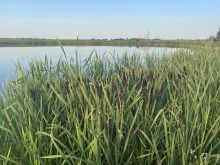Alberta researchers have found a promising new clover that seems to withstand winterkill and heavy grazing, and outyield other clovers and alfalfas.
Kura clover had the highest yield in test plots after three years of testing, said Myron Bjorge, Alberta Agriculture’s provincial forage specialist and a member of the Western Forage Beef Group that organized the plots.
“I can tell you kura clover was the best one at maintaining its plant populations,” said Bjorge of Lacombe.
Because of harsh weather and little snow cover, winterkill was a problem across the Prairies last year, affecting thousands of acres. At Bjorge’s test site, several of the legumes died.
Read Also

Europe holds promise for Canadian lentils
Pulse Canada is trying to help boost lentil consumption in Europe, which is already the fourth largest market.
But Bjorge said kura clover survived and continued to be high yielding. He thinks the crop will shine as a much-needed pasture legume.
“We don’t have a legume that is really well suited to pasture.”
Jan Slomp, a dairy farmer from Rimbey, Alta., didn’t have to wait for the final research results after seeing the clover in the test plots. He liked what he saw.
“This is a super hardy clover,” said Slomp, who seeded 55 acres of kura this year and plans to seed more next year.
“I’ve been looking for 12 years for a legume suited to my permanent pasture,” he said.
“When I saw it in the test plots, I thought, ‘jeepers, that’s the thing I want to try.'”
He said he has read about kura clover for years in American grazing magazines.
While he has tried red clover in the past, it normally lasted about three years before it was gone. Some white clover volunteers, but is not shade tolerant and is often shaded by rapidly growing grass.
Kura competes well even with fast-growing orchard grass.
Two plots were established during the trials, one in the black soil zone near Lacombe and a second in the grey wooded soil near Bentley.
Bjorge said the kura clover was slow to establish, but once it did it survived well. Researchers attribute its longevity to an extensive root system. The plant’s taproot can reach up to 60 centimetres and has a high root-to-shoot ratio.
During the trials, plots were trimmed frequently to simulate grazing conditions. Even after frequent clipping, kura clover outyielded alfalfa, cicer milkvetch, white clover, red clover, alsike clover and birdsfoot trefoil.
Bjorge said red clover kept pace with the kura clover in the first two years, but died from winterkill last year.
Kura clover was named for its region of origin near the Kura River in the Caucasus Mountains east of the Black Sea.
Bjorge said the legume intrigued researchers after it showed promise in American research trials.
Slomp said he hopes kura clover will reduce his fertilizer bill.
“I think nitrogen fertilizer in Canada is outrageously expensive.”














